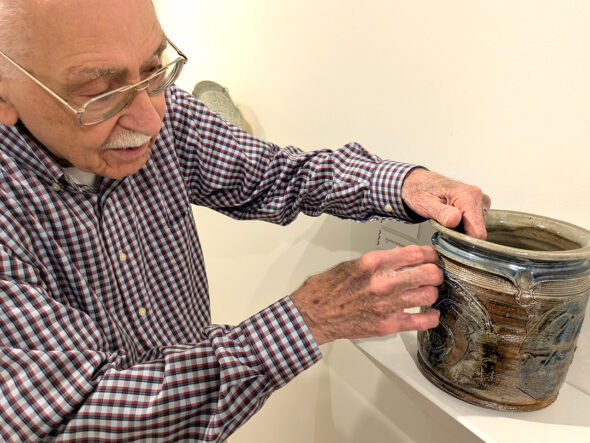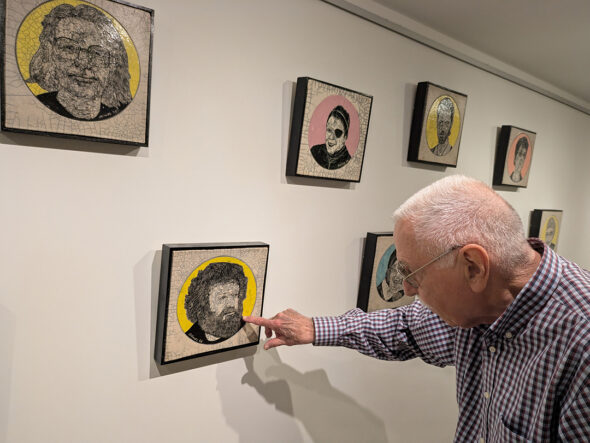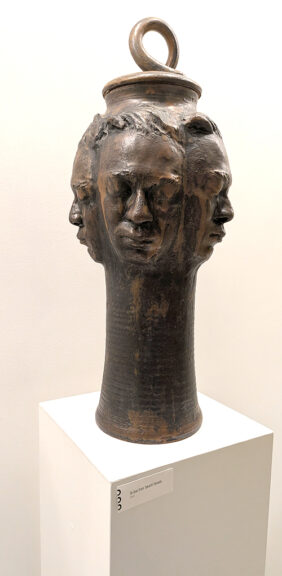
“Clayworks” represents 64 years of the work of potter Bruce Grimes. Above, he demonstrates how he created textures by hand on a post featured in the show. Visible just below the lip of the pot is an indentation left by Grimes’ thumb — one of four that encircles the piece. (Photo by Lauren "Chuck" Shows)
Elder Stories | Bruce Grimes’ 64 years of ‘Clayworks’
- Published: September 20, 2025
ELDER STORIES
A series of occasional articles exploring the lives and contributions of villagers 80 years of age and older. If you’d like to suggest a person for the News to consider for this series, email ysnews@ysnews.com.
Local resident and potter Bruce Grimes loves a challenge.
Walking around Cedarville University, where he served as a ceramics instructor for 11 years, the 85-year-old Grimes threw his memory back in time to his youth, when he joined his high school’s basketball team. His coach, he said, proclaimed: “Damn, you’re clumsy!”
“So I took my basketball home, and at the end of the summer, the ball was completely smooth, I’d practiced so much,” Grimes said. “It was the same when I got into clay.”
In the brightly lit 220 Gallery in Cedarville’s Student Center, a small fraction of work representing Grimes’ 64 years as a pottery artist are currently on display as part of a retrospective show, entitled “Clayworks.” The pieces there serve as a kind of visual testimony to Grimes’ tenacious creative history.
“You know, most children make mud pies, and they grow out of it,” Grimes said. “I’m still making mud pies.”
Born and raised in Decatur, Illinois, Grimes landed in Decatur’s Millikin University on an athletics scholarship, but aimed his studies toward the arts. His initial focus, however, wasn’t pottery, but painting and printmaking. He earned his bachelor’s degree in those media before moving to Athens to pursue an MFA at Ohio University.
He was still focused on painting and printmaking when he decided to take an elective in ceramics taught by the late Henry Huan Lin, who founded OU’s ceramics program. (Lin’s daughter, Maya Lin, is well-known as the designer of the Vietnam Veterans Memorial.)
Before he knew it, Grimes said, he was dedicating dozens of hours to that single class.
“I was there every night and all day Saturday and Sunday,” he said. “[Lin] asked me if I wanted to be his teaching assistant, and I thought, ‘Well, I’m here all the time — might as well make a little money while I do it!’”
As Grimes spent more time in ceramics, he reshaped the form of his own creative focus, pursuing his master’s in ceramics. He said he spent a lot of time as a graduate student experimenting with his own glazes — the coating that enshrines fired clay pieces — and completing more than 60,000 glaze tests to discover how each reacted to the kiln.

(Photo by Lauren “Chuck” Shows)
Glazing was one thing, Grimes said, but one of his biggest challenges as a student was learning to throw on the potter’s wheel. It didn’t come easily, he said — but his tenacity of spirit wouldn’t allow him to shy away from eventual mastery.
“I couldn’t even center the clay [on the wheel] at first,” he said, noting that he was helped along in class, at first, by two fellow students — a professional dancer who was “about four-foot-ten,” he reckoned, and Mrs. Robbins, who was “probably about 55.”
“They would come by and help me center the clay, and I was in tears, thinking, ‘What am I doing?’” he said. “But boy, I worked at it, and worked at it, and worked at it. … So it was a real challenge.”
He added, with a grin: “But I’m competitive in nature.”
After completing his studies, Grimes headed off into the wide world with his wife, Joyce, to whom he’s been married for 67 years. In 1964, he landed in Ohio for the first time, helping to found the ceramics program at Ohio Northern University in Ada, where he taught for six years.
It would be a while before the Grimeses — who by the ’70s also included daughters Andrea, Brenda and Christina — returned to Ohio. Grimes went next to teach at University of Wisconsin–Green Bay.
“I was there almost 12 years, but I was so tired of winter in Green Bay,” he said; his next move was to University of North Florida in Jacksonville, where he served as both a professor of fine arts and the director of athletics. Several years later, the family moved to Canyon, Texas, where he was a full-time arts professor at West Texas A&M University, while again serving as director of athletics, as well as director of development.
“I tell people, ‘They give you titles instead of money,’” Grimes said with a laugh. “But I found that I liked leadership roles, and connecting with people.”
Grimes has held a number of those roles; after his stint in Texas in the ’80s, he returned to Ohio Northern in the early ’90s as a development director, and later worked as president and CEO of the nonprofit Crow Canyon Archaeological Center in Colorado, among other moves and shifts over the years. In the Miami Valley, he served for more than a decade as development director for a Springfield-based nonprofit, The Nehemiah Foundation, which helps area churches unite around charitable causes and outreach.
“We’ve lived in seven states, and so many times our daughters would be asked, ‘Oh, is your father in the military?’” Grimes said. “And then my my nephew says, ‘Oh, Uncle Bruce can’t hold down a job!’”
Wherever he might have been working in the world as an educator or administrator, Grimes was always a potter. Over the course of his creative career, he’s been featured in more than 300 shows, and at one point his work was offered for sale in nearly 70 shops and galleries. The reach of his work may be influenced by the prolificacy of his output; Grimes said he’s often taken on large commissions of dozens — if not hundreds — of pieces at a time. He recalled filling an order of more than 2,000 works for a single client one year, while also producing work for other clients and for his own artistic interests.

(Photo by Lauren “Chuck” Shows)
“And after that, she came in and asked, ‘Can you do 500 pieces by the end of the month?’ And of course I said, ‘Yeah.,’ ” he said. “After I did it, I was sick, but I got them done.”
He added: “I used to work all through the night, but now I’m a plugger — I get a little work done every day, and pretty soon, I’ve got a lot of work done.”
In 2000, Bruce and Joyce Grimes moved to Yellow Springs to be nearer to their daughter, Christina, and grandchildren, Meredith and Forrest. While he was already known in Ohio as an artist — “I had a bigger reputation here than I did in the Southwest,” he said — Grimes said it was his daughter’s influence that got him involved with John Bryan Community Pottery, where he’s currently artist in residence emeritus.
“She went down there and sold me to them — I told her I should make her my vice president of publicity and sales,” he said. “The director at the time said, ‘Your daughter tells me you would like to teach here.’ I said, ‘Well, I love to teach,’ and he gave me some classes, and then it just grew that way.”
Grimes is set to teach a workshop at the Bryan Center in a little over a month, in which he said he intends to introduce some printmaking techniques to his students — techniques from his first foray into his own arts studies, and which, along with painting, he said he still incorporates into his pottery.
He pointed, in particular, to a series of works from a 2008 installation that hung at the Emporium, entitled “It Takes a Village.” The collection of works features a number of well-known Yellow Springs faces — Lynn Hardman, Corinne Pelzl, Beth Holyoke and the late Terry Snyder, among others — against circular backgrounds, carved intaglio-style into the surface of the clay.
“These are really similar to print-making techniques,” he said. “I would find interesting faces and make a drawing.”
“It Takes a Village” serves as a visual reminder of the community that Grimes has formed in Yellow Springs of fellow artists, neighbors and friends. That community came to his aid in 2017, rallying around Grimes following a fire that destroyed his kiln and studio. Fellow potter Lisa Goldberg organized a fundraiser, and the Bryan Center was one of several places that offered Grimes a place to work and store his pieces. These days, he said, his grandson has helped him build a studio in his garage — “My granddaughter calls it a ‘garudio,’” he said — where he continues to work.
There’s a variety of color and form in the pieces on display in Grimes’ “Clayworks” retrospective, owing to the artist’s experimentation over the years. A trio of pieces greets viewers as they enter the gallery: large, vase-like structures, each of which bear faces captured long ago in plaster molds and recreated in clay. One piece, created in 1969, is encircled by repetitions of the face of Takashi Yamada, a friend and fellow artist. Another, Janus-like piece from 1968 features two faces looking, depending on your vantage point, ahead and behind, crowned at the top with a wide, yawning headdress with irregular edges.
“I was trying to express the quality of clay,” Grimes said of the piece’s asymmetrical crown, which is mirrored in an earlier work elsewhere in the “Clayworks” exhibition. “It’s very sculptural. … We think of clay as being all smooth and this and that, but this is another quality of clay.”
A devotee of the high-fire raku method — “I went to my first raku workshop in 1962 and I just fell in love with that process,” he said — many of the works on display sport the tell-tale crackle and dark spots of raku. A keen eye will also spot a motif that runs through many works: colorful circles, some of which contain other forms; one vessel features individually painted rainbow trout growing out of bright, blue circles.
“When I was in junior high school, I would make drawings — probably when I should have been studying — and I was always drawing circles and oblongs,” Grimes said. “And when I was in the Southwest, there were two things that stuck in my mind: the moon at night and the sun in the daytime. So I started doing circles in my work, and they’re really symbolic of what I saw, lying out under the sky.”
Grimes’ work encompasses both the purely aesthetic and the beautiful-and-utilitarian. Amid etched tiles and molded faces, there are bowls, platters and vases. With many of the pieces in the show on loan from the various places they’ve ended up over the years, the exhibition holds the distinction of including works that have been not only displayed, but regularly used over the years.
“My daughters have at least 200 pieces; a lot of these I got out of Christina’s cupboard,” Grimes said. “She said, ‘Dad, I said take a couple,’ and I told her, ‘Well, I took a couple — at a time.’”
And though the two-headed piece from 1968 was not created for this purpose, Grimes said it was used in a mortgage-burning ceremony at Church of the Brethren in his hometown of Decatur.
“When they paid off the mortgage on the church, they burned it in this piece, and the pastor said, ‘Now we can look forward and remember the past where we came from,’” Grimes said.
He added that he’d had no idea the piece ended up in the church — the same church he attended growing up and in which he and Joyce were married — until he reached out looking to find it and include it in the show.
It’s been one of the delights, he said, of putting together “Clayworks” for display: Getting in touch not only with his own past work and history, but with the folks who have held onto the pieces for all these years.
“This is the most fun show I’ve ever done, because I’d lost connections with a number of these people, and I forgot about some pots,” he said, adding that some Illinois friends he hasn’t seen in years are making the trek to see the show this weekend.
With most of his life having been spent forming clay, Grimes said he can’t foresee a time when he’ll close down the kilns in his “garudio” or put away his potter’s wheel. He acknowledged, however, that he’s had to adjust the way he works with his most precious tools — his hands. He’s had two surgeries on his hands in the last several years to address arthritis.
“So I’ve had to learn all these new techniques,” he said.
Nevertheless, Grimes remains prolific; at present, he’s working on filling an order of around 45 pieces for a client. He still has 25 bowls to finish.
“When I get done here, I’m gonna change clothes, go on back and throw those bowls,” he said.
“Clayworks” is on display in the 220 Gallery at Cedarville University through Sept. 23.
The Yellow Springs News encourages respectful discussion of this article.
You must login to post a comment.
Don't have a login? Register for a free YSNews.com account.















No comments yet for this article.